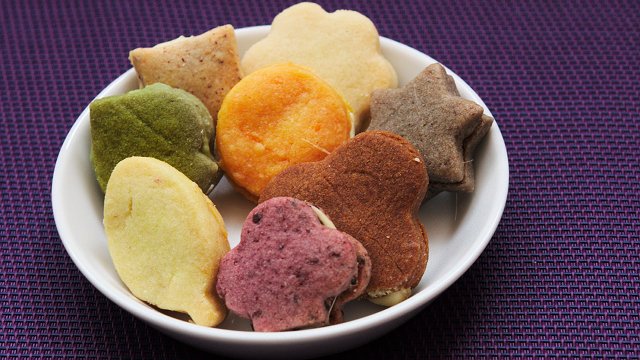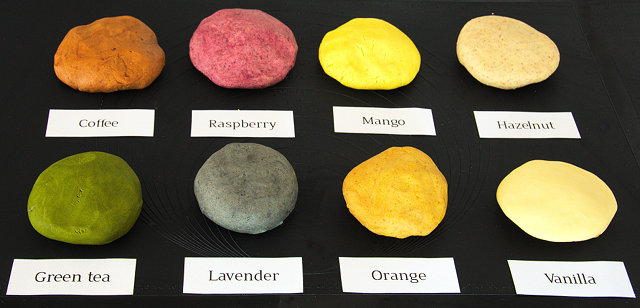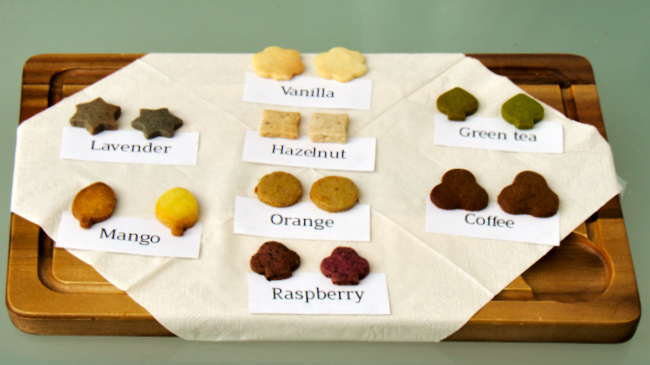 I had always associated shortbread cookies with boredom: heavy, unremarkable flavors like vanilla, almond, or—when the chef feels particularly adventurous—hazelnut and rum. Smitten Kitchen’s recipe changed that, using the very plainness that bored me as a canvas for the fresh flavor of matcha. Even before baking them, I could taste the mild astringency of the green tea, the combination of tender cookie and creamy white chocolate ganache filling allowing the grassy notes to shine.
I had always associated shortbread cookies with boredom: heavy, unremarkable flavors like vanilla, almond, or—when the chef feels particularly adventurous—hazelnut and rum. Smitten Kitchen’s recipe changed that, using the very plainness that bored me as a canvas for the fresh flavor of matcha. Even before baking them, I could taste the mild astringency of the green tea, the combination of tender cookie and creamy white chocolate ganache filling allowing the grassy notes to shine.
I would have baked them the minute I discovered them, but I had no matcha. I started thinking of alternatives, but most were ingredients I didn’t have handy. I wondered which one would be best but, even after asking a question on our site, could not decide. There seems to be no previous experience with fresh, lively shortbread cookies.
If I wanted to know, I would have to find out myself.

I had a long and hard discussion with my inner child about how many different flavors I can bake in one sitting, and we settled on six exotic flavors and two traditional ones as a benchmark (and as consolation in case the exotic ones failed.) The chosen flavors varied both in freshness and texture. I decided against artificial flavorings: they wouldn’t produce a worthy challenge, and cookies with the flavor complexity of a gummi bear aren’t worth the time. I went with one flavor per type of flavoring agent, hoping that two different flavors from the same type – e.g. lemon zest and orange zest – will behave similarly.
Artificial flavors were out, but I did borrow one idea from candy makers: artificial coloring. The bright green color the matcha produced in the original cookies announces the freshness of their taste, and makes them a good alternative to traditional Easter candy, or an eye-catcher in a picnic basket on a summer evening. I didn’t use the saturated primary colors directly from the bottle—instead, I mixed them into muted colors, to fit with the natural taste of the cookies. The result looked great.
I made each batch of dough with 75 g flour, 50 g butter, 25 g confectioner’s sugar, approximately 10 g of flavoring, and a few drops of liquid until everything came together. I worked the dough at room temperature for better pliability, rolled it to approximately 3 mm ( ⅒ inch) thick, and cut it with cookie cutters. I re-kneaded and rolled out the offcuts without adding flour as many times as it took to use up all of the dough. I then chilled the cut cookies in the freezer for a few minutes, until the dough hardened, before baking them at 160°C (320°F) for around 12 minutes per batch. The low temperature should have prevented browning from messing up the colors. Sadly, some cookies browned, but this may be due to the oven’s inaccuracy rather than the target temperature.

A small rainbow of doughs
Coffee
 I used instant coffee for this one. It is easy to find, and I expected it to produce a smooth texture. But as it is not soluble in fat, I dissolved it in a little water, which resulted in a thick, slightly lumpy paste. It needed lots of kneading to distribute the color evenly (I didn’t use food coloring), but even though the coloring wasn’t perfect in the dough, the baked cookies are uniform. And of course, browning was not a problem here. The taste was rather intense, even though I only used 6 g of instant coffee. I like this one a lot, even though it isn’t in the “fresh” category.
I used instant coffee for this one. It is easy to find, and I expected it to produce a smooth texture. But as it is not soluble in fat, I dissolved it in a little water, which resulted in a thick, slightly lumpy paste. It needed lots of kneading to distribute the color evenly (I didn’t use food coloring), but even though the coloring wasn’t perfect in the dough, the baked cookies are uniform. And of course, browning was not a problem here. The taste was rather intense, even though I only used 6 g of instant coffee. I like this one a lot, even though it isn’t in the “fresh” category.
Green tea
 I used matcha powder, which is available in Asian grocery stores and online. It is expensive, but the intense, complex flavor makes it worth the money. It’s very easy to work with, colored the cookies really well (I added no food coloring to this batch), and the fine powder made the second best consistency dough, after plain vanilla. The taste was really great, it is my favorite of all flavors I tried. It is slightly prone to browning, but it doesn’t look too bad when it happens. I can only recommend it – easy to make, excellent results.
I used matcha powder, which is available in Asian grocery stores and online. It is expensive, but the intense, complex flavor makes it worth the money. It’s very easy to work with, colored the cookies really well (I added no food coloring to this batch), and the fine powder made the second best consistency dough, after plain vanilla. The taste was really great, it is my favorite of all flavors I tried. It is slightly prone to browning, but it doesn’t look too bad when it happens. I can only recommend it – easy to make, excellent results.
Hazelnut
 For this flavor, I used hazelnut flour from the supermarket, which has the consistency of semolina. This is one of the two traditional tastes, as shortbread cookies with nut flours are a popular Christmas time treat in Central Europe. The dough was slightly gritty, but OK to handle. The nut flour gave it a textured beige appearance, I did not add food coloring. The taste was as expected from this traditional recipe – solid and good, but nothing exciting.
For this flavor, I used hazelnut flour from the supermarket, which has the consistency of semolina. This is one of the two traditional tastes, as shortbread cookies with nut flours are a popular Christmas time treat in Central Europe. The dough was slightly gritty, but OK to handle. The nut flour gave it a textured beige appearance, I did not add food coloring. The taste was as expected from this traditional recipe – solid and good, but nothing exciting.
Lavender
 I had to order lavender online, and it took me some time to find organic dried blossoms (cosmetic grade lavender might contain pesticides). I ground it using a granite mortar and pestle. The already pale greenish blossoms produced an unappetizing mold-green powder. I added a slightly purplish blue using food colors, and the green-beige dough desaturated it to a beautiful lavender shade. The texture was less successful: despite repeated sifting, some haylike splinters remained in the cookies. The dough was also not as easy to work as the smoother ones. The taste was nice, but it is definitely not for everyone – many people associate the strong lavender scent with soap. Sadly, the browned parts looked completely out of place on the violet-blue cookies. The results are interesting, but the combination of the highly unusual taste, time-consuming grinding, and browning problems mean that I won’t be making these often.
I had to order lavender online, and it took me some time to find organic dried blossoms (cosmetic grade lavender might contain pesticides). I ground it using a granite mortar and pestle. The already pale greenish blossoms produced an unappetizing mold-green powder. I added a slightly purplish blue using food colors, and the green-beige dough desaturated it to a beautiful lavender shade. The texture was less successful: despite repeated sifting, some haylike splinters remained in the cookies. The dough was also not as easy to work as the smoother ones. The taste was nice, but it is definitely not for everyone – many people associate the strong lavender scent with soap. Sadly, the browned parts looked completely out of place on the violet-blue cookies. The results are interesting, but the combination of the highly unusual taste, time-consuming grinding, and browning problems mean that I won’t be making these often.
Mango
 Fresh fruits would have changed the shortbread texture due to their high water content, so I tried lightly sugared dehydrated mango pieces, available at many stores. I tried to produce a uniform paste in the mortar, but the results were terrible. Even after lots of work, the paste was way too sticky, some pieces were too big (up to 2 mm/0.08 inches) and the paste didn’t blend with the dough. The cookie cutter would often meet one of the big pieces and not be able to cut through it, resulting in a piece of mango sticking out of the otherwise clean edge of a cookie. It gave almost no color by itself, so I used a dash of pure yellow. The browning made the mango cookies nicer, giving them the natural look of a mango more ripe on one side than the other. The taste was OK, but not especially mango-y. Overall, this was the worst batch in the whole experiment, despite the nice looks.
Fresh fruits would have changed the shortbread texture due to their high water content, so I tried lightly sugared dehydrated mango pieces, available at many stores. I tried to produce a uniform paste in the mortar, but the results were terrible. Even after lots of work, the paste was way too sticky, some pieces were too big (up to 2 mm/0.08 inches) and the paste didn’t blend with the dough. The cookie cutter would often meet one of the big pieces and not be able to cut through it, resulting in a piece of mango sticking out of the otherwise clean edge of a cookie. It gave almost no color by itself, so I used a dash of pure yellow. The browning made the mango cookies nicer, giving them the natural look of a mango more ripe on one side than the other. The taste was OK, but not especially mango-y. Overall, this was the worst batch in the whole experiment, despite the nice looks.
Orange
 I used freshly grated orange zests for this variant, as finely grated as possible. I used food coloring, a yellowish orange with the smallest hint of blue to reduce the saturation. The resulting dough was rather uneven, and the taste was dominated by the heavy aroma of the orange essential oils, instead of the freshness of orange slices. All in all, they were disappointing.
I used freshly grated orange zests for this variant, as finely grated as possible. I used food coloring, a yellowish orange with the smallest hint of blue to reduce the saturation. The resulting dough was rather uneven, and the taste was dominated by the heavy aroma of the orange essential oils, instead of the freshness of orange slices. All in all, they were disappointing.
Raspberry
 I ordered freeze-dried raspberries online. They were really dry and hard, so I ground them in the mortar. This worked better than the lavender. Sifting removed the pips, but lots of the red powder was lost too, so I added them back, making a gritty dough. The decision wasn’t very fortunate: while the pips provide some variance in texture, they also have the annoying habit of sticking into teeth. Despite this slight drawback, this was one of the best flavors I made. It reminded me more of raspberry tea than of fresh raspberries, but it was very tasty. The bright powder created lots of color on its own, but I still added a bit of dark red food coloring, with the slight hint of purple typical for anthocyanins. The result was nice in taste and appearance, but the browned parts looked weird.
I ordered freeze-dried raspberries online. They were really dry and hard, so I ground them in the mortar. This worked better than the lavender. Sifting removed the pips, but lots of the red powder was lost too, so I added them back, making a gritty dough. The decision wasn’t very fortunate: while the pips provide some variance in texture, they also have the annoying habit of sticking into teeth. Despite this slight drawback, this was one of the best flavors I made. It reminded me more of raspberry tea than of fresh raspberries, but it was very tasty. The bright powder created lots of color on its own, but I still added a bit of dark red food coloring, with the slight hint of purple typical for anthocyanins. The result was nice in taste and appearance, but the browned parts looked weird.
Vanilla
 I used a synthetic flavor dissolved in a propylene glycol base for this one. It was good enough, but real vanilla extract (which I didn’t have handy) would have produced superior cookies. This was the “gold standard” dough, made by the traditional recipe, no flavoring beside the imitation vanilla, no food coloring. It went as well as expected and produced nice, crisp, unremarkable cookies. Still, it was better than some of the less successful fruit flavors like mango and orange.
I used a synthetic flavor dissolved in a propylene glycol base for this one. It was good enough, but real vanilla extract (which I didn’t have handy) would have produced superior cookies. This was the “gold standard” dough, made by the traditional recipe, no flavoring beside the imitation vanilla, no food coloring. It went as well as expected and produced nice, crisp, unremarkable cookies. Still, it was better than some of the less successful fruit flavors like mango and orange.

I was drawn to the recipe both because it used flavoring and because gluing the cookies with white ganache promised an interesting texture change. I was sure that all these tastes will go well with white chocolate (frankly, what doesn’t go well with white chocolate?) and I was right. Sadly, I ran into trouble with the ganache.
After the long baking session, I didn’t bother to convert the amounts from the original recipe, but stirred white chocolate into an equal amount of hot whipping cream, just like I would do with dark ganache. Confectioners reading along are probably smirking. Dark chocolate is made with cocoa solids, which contain a large amount of starch. White chocolate contains cocoa butter but no starch from the bean – it is “filled” with milk solids and sugar. It contains no thickener. My ganache stayed liquid after cooling.
As I had no more white chocolate, I tried to salvage the ganache by adding 0.5% xanthan gum, the lowest percentage Khymos recommends for thickening. With stirring, it started congealing, but unlike a creamy starch-thickened hydrocolloid it had a gooey texture which stuck to everything. The other side effect was worse: the aroma all but disappeared, leaving a flavor dominated by sugar. The wonderfully complex smell of white chocolate was gone. The ganache did a good job of gluing the cookies, but I am sure that one made with less cream and no xanthan gum would have crushed it tastewise.
I found the flavor effect quite interesting, especially because I haven’t read about it in other sources. As informative as the e-book I linked is for the physical properties of hydrocolloids, it doesn’t do a cook any good if the thickener chosen for its ease of use turns out to have weird side effects. Stay tuned for a future blog post describing experiments with the effect of different thickeners!

The Smitten Kitchen recipe for green tea sandwiches uses 3-4 tablespoons (45 to 60 g) cream for 4 ounces (110 g) white chocolate. This will probably work, because 1) my 1:1 ratio was way too liquid, so such a drastic reduction must be good, and 2) recipes from them tend to work well. I had lots of ganache left over, but this could be due to the stickiness of my ganache; maybe using the real thing produces a thicker ganache layer (mmmm!)
Conclusion: try these cookies. They are fun. And if you find a way to make my bad ones work, or if you try new and even more exotic flavors, please leave a comment, I’d love to hear how it went.
Filed under baking experiments
Tagged: cookies

Rumtscho, love your blog post! Found you through the link in your comment at Kymos’s recipe collection. I have a suggestion for the mango cookies. If you’re in the U.S., try Trader Joe’s freeze-dried mango slices (very tasty). The ground slices may work in flavor, texture, and color. They also have freeze-dried strawberries and blueberries. If you’re not fortunate to have a local TJ, you can probably find freeze-dried mango online like the raspberries. Happy baking!
Interesting – I found this page searching for information on hydrocolloids, and happened upon the note about your attempt to thicken the ganache with xanthan gum.
I’ve tried similar things in the past, but when making truffles; I noted a “gummy” texture, but nothing so dramatic as happened to you above! I wanted to ask, do you recall if the percentage indicated was based on the full mass of the recipe, or only the liquid component? I.e., did you add x% of the recipe, or just x% of the cream?
Thanks! Tim